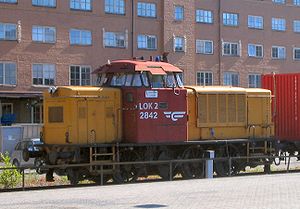NSB Di 2

Di 2 842 at Oslo Central Station
|
|||||||||||||
|
|||||||||||||
|
|||||||||||||
|
|||||||||||||
|
|||||||||||||
| Type and origin | |
|---|---|
| Power type | Diesel-hydraulic |
| Builder |
Maschinenbau Kiel Thune |
| Build date | 1954–73 |
| Specifications | |
|---|---|
| Configuration: |
|
| • UIC | C |
| Length | 10 m (32 ft 10 in) |
| Loco weight | 45 t (44 long tons; 50 short tons) (MaK); 47.4 t (46.7 long tons; 52.2 short tons) (Thune) |
| Transmission | Hydraulic |
| Performance figures | |
|---|---|
| Maximum speed | 50 km/h (31 mph) (shunting); 80 km/h (50 mph) (main line) |
| Power output | 423 kW (567 hp) (MaK); 441 kW (591 hp) (BMV) |
| Career | |
|---|---|
| Operators | Norwegian State Railways |
| Number in class | 54 |
| Numbers | 2 801 – 2 854 |
| First run | 1954 |
NSB Di 2 was a class of 54 diesel-hydraulic locomotives operated by the Norwegian State Railways (NSB). Six units were built by Maschinenbau Kiel (MaK) of Kiel, Germany, and the remaining by Thune in Oslo. The locomotives were used for shunting and for local and light freight trains throughout NSBs network. Based on MaK's 575C design, the locomotives were 10.0 meters (32 ft 10 in) long and had a C wheel arrangement.
The first six units were built by MaK and were delivered between 1954 and 1957. Thune delivered its first two units in 1958, with a MaK prime mover. These eight had a power output of 423 kilowatts (567 hp). All later production was carried out by Thune using prime movers from Bergen Mekaniske Verksted, with a power output of 441 kilowatts (591 hp). Further series consisted of fifteen units in 1962, sixteen in 1963–64, nine in 1970 and six in 1973.
One unit was upgraded with a Caterpillar prime mover and a new cab in 1997, and designated Skd 225. It remained in use until 2012, while the last of the other units were retired in the 2000s. Four locomotives have been preserved at heritage railways.
NSB's first diesel locomotive was the Krupp-built Di 1, delivered in 1942. It had a poor operational record, being plagued with technical faults. Based on the experiences with the locomotives, NSB started in the 1950s to look into additional diesel-hydraulic locomotives for its un-electrified lines. NSB chose to test out the MaK 800D with a power output of 627 kilowatts (841 hp) and a D wheel arrangement. Although satisfied with the performance, NSB felt the locomotive was too powerful and instead opted for the smaller 575C. The 575C design had been delivered with two units to the Nynäs Line in Sweden in 1951. NSB's class was designated Di 2 and the three first locomotives, numbered 801 through 803, were delivered in 1954.
...
Wikipedia
